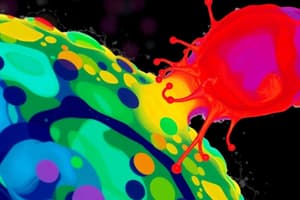Podcast
Questions and Answers
Which type of transport protein changes shape during the transport process?
Which type of transport protein changes shape during the transport process?
- Carrier proteins (correct)
- Transporters
- Pumps
- Channels
What is the process called when molecules are transported against their concentration gradient?
What is the process called when molecules are transported against their concentration gradient?
- Active transport (correct)
- Secondary active transport
- Facilitated diffusion
- Diffusion
Which type of transport protein requires the input of energy?
Which type of transport protein requires the input of energy?
- Transporters
- Carrier proteins
- Pumps (correct)
- Channels
What is the name of the glucose transporter that increases membrane permeability to glucose?
What is the name of the glucose transporter that increases membrane permeability to glucose?
Which type of transport protein allows substances that would not otherwise cross the membrane to pass through?
Which type of transport protein allows substances that would not otherwise cross the membrane to pass through?
What is the term for the concentration and charge gradient collectively?
What is the term for the concentration and charge gradient collectively?
What is the term for the passive transport of substances that would not otherwise cross the membrane?
What is the term for the passive transport of substances that would not otherwise cross the membrane?
Which type of transport protein allows ions to diffuse through down their electrochemical gradients?
Which type of transport protein allows ions to diffuse through down their electrochemical gradients?
What is the name of the membrane protein that uses ATP to transport Na+ and K+ against their concentration gradients?
What is the name of the membrane protein that uses ATP to transport Na+ and K+ against their concentration gradients?
What is the term for the process that makes it possible for cells to engage in secondary active transport?
What is the term for the process that makes it possible for cells to engage in secondary active transport?
Which of the following best describes the structure of plasma membranes?
Which of the following best describes the structure of plasma membranes?
What is the term used to describe the movement of water across a plasma membrane?
What is the term used to describe the movement of water across a plasma membrane?
What is the main function of membranes in cells?
What is the main function of membranes in cells?
What happens to phospholipids when placed in water?
What happens to phospholipids when placed in water?
What is the permeability of phospholipid bilayers?
What is the permeability of phospholipid bilayers?
Which type of molecules move across phospholipid bilayers quickly?
Which type of molecules move across phospholipid bilayers quickly?
What is the term used to describe the hydrophilic and hydrophobic regions of phospholipids?
What is the term used to describe the hydrophilic and hydrophobic regions of phospholipids?
What is the role of membrane proteins in the passage of substances across the plasma membrane?
What is the role of membrane proteins in the passage of substances across the plasma membrane?
What is the term used to describe the formation of phospholipid bilayers without the input of energy?
What is the term used to describe the formation of phospholipid bilayers without the input of energy?
What is the function of phospholipids in relation to water molecules?
What is the function of phospholipids in relation to water molecules?
Which of the following factors can influence the behavior of the cell membrane?
Which of the following factors can influence the behavior of the cell membrane?
Which of the following statements about bond saturation and membrane permeability is true?
Which of the following statements about bond saturation and membrane permeability is true?
Which of the following factors can decrease membrane permeability?
Which of the following factors can decrease membrane permeability?
Which of the following statements about membrane fluidity is true?
Which of the following statements about membrane fluidity is true?
Which of the following is a form of passive transport?
Which of the following is a form of passive transport?
What happens when there is a difference in solute concentration across a membrane?
What happens when there is a difference in solute concentration across a membrane?
Which of the following statements about osmosis is true?
Which of the following statements about osmosis is true?
What happens to a cell in a hypertonic solution?
What happens to a cell in a hypertonic solution?
Which of the following is a characteristic of the fluid-mosaic model of membrane structure?
Which of the following is a characteristic of the fluid-mosaic model of membrane structure?
What are integral proteins?
What are integral proteins?
Flashcards
Carrier Proteins
Carrier Proteins
Transport proteins that change shape during molecule transport.
Active Transport
Active Transport
Movement of molecules against their concentration gradient, needing energy.
Primary Active Transport
Primary Active Transport
Active transport that directly uses energy (like ATP).
GLUT
GLUT
Signup and view all the flashcards
Channel Proteins
Channel Proteins
Signup and view all the flashcards
Electrochemical Gradient
Electrochemical Gradient
Signup and view all the flashcards
Facilitated Diffusion
Facilitated Diffusion
Signup and view all the flashcards
Ion Channels
Ion Channels
Signup and view all the flashcards
Na+/K+ pump
Na+/K+ pump
Signup and view all the flashcards
Secondary Active Transport
Secondary Active Transport
Signup and view all the flashcards
Fluid-Mosaic Model
Fluid-Mosaic Model
Signup and view all the flashcards
Osmosis
Osmosis
Signup and view all the flashcards
Bilayer
Bilayer
Signup and view all the flashcards
Selectively Permeable
Selectively Permeable
Signup and view all the flashcards
Diffusion
Diffusion
Signup and view all the flashcards
Hypertonic Solution
Hypertonic Solution
Signup and view all the flashcards
Crenation
Crenation
Signup and view all the flashcards
Phospholipid
Phospholipid
Signup and view all the flashcards
Hydrophilic
Hydrophilic
Signup and view all the flashcards
Hydrophobic
Hydrophobic
Signup and view all the flashcards
Spontaneous Self-Assembly
Spontaneous Self-Assembly
Signup and view all the flashcards
Membrane Fluidity
Membrane Fluidity
Signup and view all the flashcards
Study Notes
Transport Proteins and Mechanisms
- Transport proteins that change shape during the transport process are called carrier proteins.
- Transporting molecules against their concentration gradient is known as active transport.
- Primary active transport requires energy input, typically in the form of ATP.
- The glucose transporter that increases membrane permeability to glucose is known as GLUT (Glucose Transporter).
- Channel proteins allow substances that cannot cross the membrane otherwise to pass through.
- The collective term for the concentration and charge gradient is the electrochemical gradient.
- Facilitated diffusion describes the passive transport of substances that otherwise cannot cross the membrane.
- Ion channels enable ions to diffuse through the membrane down their electrochemical gradients.
- The membrane protein responsible for using ATP to transport Na+ and K+ against their concentration gradients is called the Na+/K+ pump.
- The process that allows cells to engage in secondary active transport relies on the established electrochemical gradients.
Membrane Structure and Function
- Plasma membranes are best described by the fluid-mosaic model, which highlights their dynamic structure composed of lipids and proteins.
- The term for the movement of water across a plasma membrane is osmosis.
- Membranes function primarily to control the passage of substances in and out of cells, maintaining homeostasis.
- When placed in water, phospholipids spontaneously form bilayers with hydrophobic tails inward and hydrophilic heads outward.
- Phospholipid bilayers are selectively permeable, allowing certain molecules to cross while blocking others.
- Small, nonpolar molecules move across phospholipid bilayers quickly due to their compatibility with the hydrophobic core.
- Phospholipids possess hydrophilic (water-attracting) heads and hydrophobic (water-repelling) tails.
Membrane Dynamics and Factors Influencing Permeability
- Membrane proteins facilitate the transport of substances across the plasma membrane by acting as channels or carriers.
- The formation of phospholipid bilayers without energy input occurs through spontaneous self-assembly.
- Phospholipids interact with water molecules, creating a barrier that separates cellular compartments.
- Factors influencing cell membrane behavior include temperature, lipid composition, and cholesterol content.
- Increased unsaturation of fatty acid chains in phospholipids generally enhances membrane permeability.
- Factors that can decrease membrane permeability include saturation of fatty acids and the presence of cholesterol in certain proportions.
- Membrane fluidity is influenced by factors such as temperature and the types of lipids present.
- Diffusion, a form of passive transport, occurs naturally along concentration gradients, moving from high to low concentration.
- When there is a difference in solute concentration across a membrane, osmosis drives water movement toward the area of higher solute concentration.
- In a hypertonic solution, a cell loses water, leading to crenation or shriveling.
- Integral proteins are embedded within the plasma membrane and play essential roles in transport and signaling functions.
Studying That Suits You
Use AI to generate personalized quizzes and flashcards to suit your learning preferences.




